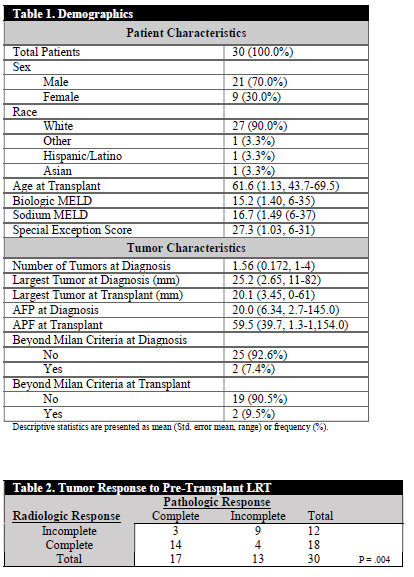Hepatocellular Carcinoma Locoregional Therapy: A Comparison of Radiologic Treatment Response and Post-Transplant Pathology
1Department of Surgery, Division of Transplant Surgery, University of Nebraska Medical Center, Omaha, NE, 2Department of Radiology, Division of Interventional Radiology, University of Nebraska Medical Center, Omaha, NE, 3Department of Pathology, University of Nebraska Medical Center, Omaha, NE, 4Department of Radiology, Division of Body Imaging, University of Nebraska Medical Center, Omaha, NE
Meeting: 2020 American Transplant Congress
Abstract number: B-145
Keywords: Hepatocellular carcinoma, Liver transplantation, Magnetic resonance imaging, Outcome
Session Information
Session Name: Poster Session B: Liver: Hepatocellular Carcinoma and Other Malignancies
Session Type: Poster Session
Date: Saturday, May 30, 2020
Session Time: 3:15pm-4:00pm
 Presentation Time: 3:30pm-4:00pm
Presentation Time: 3:30pm-4:00pm
Location: Virtual
*Purpose: Transplantation or resection is the only potentially curative treatment for Hepatocellular Carcinoma (HCC). Locoregional therapy (LRT) is used exclusively in non-transplant candidates or as bridge to transplant. This study aims to assess how tumor characteristics and radiologic response to LRT correlates to pathology and outcomes.
*Methods: This single center retrospective study reviewed records of patients with HCC who received liver transplant Aug 2016 – Feb 2019 at the University of Nebraska Medical Center (UNMC). Initial screen identified 35 patients that met criteria. Patients were excluded if LRT was performed at outside facilities or if a re-transplantation occurred without current HCC. Analysis of patient demographics, pre-operative tumor characteristics, LRT and pathology was performed utilizing Jamovi 1.0.7.0. statistical software.
*Results: Analysis was conducted on 30 patients, 21 of which had LRT, which included 67 individual tumors, 35 of which had LRT. Radiologic complete response (CR) was seen in 21 of the tumors (60.0%) versus non-CR in 13 (37.1%). Pathologic CR was seen in 17 of the tumors (48.6%) versus non-CR in 13 (37.1%), and 4 (11.4%) were pathologically non-HCC liver tumor. Discordant response was seen in 7 of 30 (23.3%) patients, 3 showing Pathologic CR/Radiologic non-CR and 4 showing Radiologic CR/Pathologic non-CR, Table 3. Survival analysis from time of diagnosis was performed with no significant differences in those patients with Pathologic CR vs. non-CR (p=0.234), Radiologic CR vs. non-CR (p=0.806), or concordant vs. discordant CR findings (p=0.114).
*Conclusions: Prior evidence has shown that radiologic imaging is known to be imperfect in determining true tumor response as seen on pathologic evaluation. This was demonstrated in this retrospective study with discordance amongst radiologic versus pathologic treatment response at a rate of 23.3%, which is similar to previously reported rates ranging 22-35%. Radiologic evaluation after LRT for HCC remains a standard post-procedural tool for determining tumor response and guide ongoing treatment.
To cite this abstract in AMA style:
Hargrove AJ, Donovan T, Fisher K, Goodenberger M, Langnas A, Merani S. Hepatocellular Carcinoma Locoregional Therapy: A Comparison of Radiologic Treatment Response and Post-Transplant Pathology [abstract]. Am J Transplant. 2020; 20 (suppl 3). https://atcmeetingabstracts.com/abstract/hepatocellular-carcinoma-locoregional-therapy-a-comparison-of-radiologic-treatment-response-and-post-transplant-pathology/. Accessed December 13, 2025.« Back to 2020 American Transplant Congress

